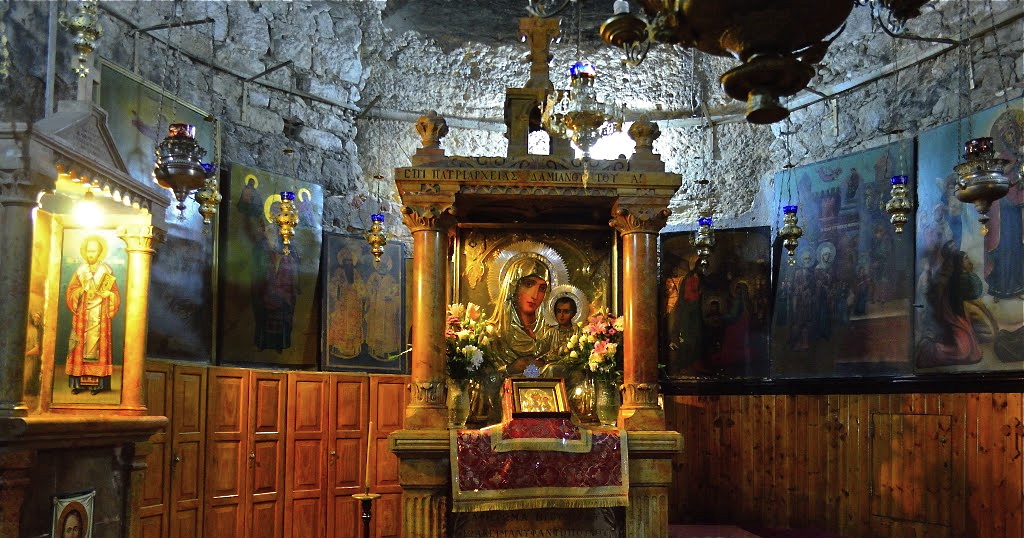Αγίου Λουκά Αρχιεπισκόπου Κριμαίας
ΛΟΓΟΣ ΕΙΣ ΤΗΝ ΚΟΙΜΗΣΙΝ ΤΗΣ ΘΕΟΤΟΚΟΥ
Τον καθένα από μας τον βασανίζει το ερώτημα: τι θα γίνει με μας και τι μας περιμένει μετά το θάνατο; Μία σαφή απάντηση σ' αυτό το ερώτημα μόνοι μας δεν μπορούμε να την βρούμε. Αλλά η Αγία Γραφή και πρώτα απ' όλα ο λόγος του Κυρίου μας Ιησού Χριστού μας αποκαλύπτουν αυτό το μυστικό. Μας το αποκαλύπτουν επίσης το απολυτίκιο και το κοντάκιο της μεγάλης αυτής γιορτής της Κοιμήσεως της Υπεραγίας Θεοτόκου και οι εκκλησιαστικοί ύμνοι που ψάλλονται σ' αυτή τη γιορτή.
Θέλω όλοι σας να καταλάβετε, γιατί ο θάνατος της Υπεραγίας Θεοτόκου και Παρθένου Μαρίας λέγεται Κοίμησή της. Ο μέγας απόστολος Ιωάννης ο Θεολόγος στο 20ο κεφάλαιο της Αποκαλύψεως μιλάει για τον πρώτο και το δεύτερο θάνατο. Ο πρώτος μόνο θάνατος, ο οποίος είναι αναπόφευκτος για όλους τους ανθρώπους, περιμένει και τους αγίους και τους δικαίους. Αλλά ο δεύτερος, ο φοβερός και αιώνιος θάνατος, περιμένει τους μεγάλους και αμετανόητους αμαρτωλούς, οι οποίοι αρνήθηκαν την αγάπη και την δικαιοσύνη του Θεού και είναι καταδικασμένοι να βρίσκονται αιωνίως σε κοινωνία με το διάβολο και τους αγγέλους του.
Στο Ευαγγέλιο του ίδιου μεγάλου αποστόλου και ευαγγελιστού Ιωάννου του Θεολόγου διαβάζουμε τα λόγια του Χριστού, τα οποία είναι πολύ στενά συνδεδεμένα με όσα γράφει η Αποκάλυψη: «αμήν αμήν λέγω υμίν ότι ο τον λόγον μου ακούων και πιστεύων τω πέμψαντί με έχει ζωήν αιώνιον και εις κρίσιν ουκ έρχεται, αλλά μεταβέβηκεν εκ του θανάτου εις την ζωήν» (Ίωάν. 5, 24).
Το ακούτε, το καταλαβαίνετε; Νομίζω ότι ακόμα και θα πρέπει να σας κινήσει την περιέργεια το γεγονός ότι όλοι όσοι υπακούουν στο λόγο του Χριστού και πιστεύουν στον Ουράνιο Πατέρα του, ο οποίος τον έστειλε, αμέσως μετά το θάνατο τους θα περάσουν στην αιώνια ζωή. Δεν υπάρχει λόγος να δικαστούν αυτοί που έχουν ζωντανή πίστη στο Θεό και υπακούουν στις εντολές του.
Και στους μεγάλους δώδεκα αποστόλους είπε ο Κύριος μας Ιησούς Χριστός: «αμήν λέγω υμίν ότι υμείς οι ακολουθήσαντές μοι, εν τη παλιγγενεσία, όταν καθίση ο Υιός του ανθρώπου επί θρόνου δόξης αυτού, καθίσεσθε και υμείς επί δώδεκα θρόνους κρίνοντες τας δώδεκα φυλάς του Ισραήλ» (Ματθ. 19, 28). Δικαστές και κατήγοροι θα είναι κατά την Φοβερά Κρίση του Θεού οι Απόστολοι του Χριστού και, βεβαίως, είναι τελείως αδύνατο να φανταστούμε να δικάζονται η Υπεραγία Θεοτόκος και Αειπάρθενος Μαρία, ο Βαπτιστής του Κυρίου Ιωάννης, οι μεγάλοι προφήτες του Θεού, ο Ηλίας και ο Ενώχ τους οποίους ζωντανούς τους πήρε ο Θεός στον Ουρανό, όλο το αμέτρητο πλήθος των μαρτύρων του Χριστού, οι δοξασμένοι από τον Θεό άγιοι αρχιερείς και θαυματουργοί με επί κεφαλής τον άγιο Νικόλαο, αρχιεπίσκοπο Μύρων της Λυκίας.
Είναι αδύνατον ακόμα και να περάσει από το μυαλό μας η σκέψη πως θα δικαστούν αυτοί, οι όποιοι άκουσαν από το στόμα του Χριστού: «Η βασιλεία του Θεού εντός υμών εστίν» (Λκ. 17, 21). Σ' αυτούς τους μεγάλους αγωνιστές του Χριστού, σαν σε πολύτιμους ναούς κατοικούσε το Άγιο Πνεύμα. Ακόμα και ζώντας στη γη, αυτοί βρισκόταν στην άμεση κοινωνία με τον Θεό, επειδή έτσι είπε ο Κύ¬ριος μας Ιησούς Χριστός: «Εάν τις αγαπήση με, τον λόγον μου τηρήσει, και ο πατήρ μου αγαπήσει αυ¬τόν, και προς αυτόν ελευσόμεθα και μονήν παρ' αυτώ ποιήσομεν» (Ίωάν. 14, 23).
Ή Υπεραγία Παρθένος Μαρία υπήρξε άχραντος ναός του Σωτήρος και σ' αυτήν κατοίκησε το Άγιο Πνεύμα και από την αγιότατη μήτρα της έλαβε το ανθρώπινο σώμα ο Υιός του Θεού, ο Οποίος κατέβηκε από τους Ουρανούς. Γι' αυτό ο σωματικός της θάνατος δεν ήταν θάνατος αλλά Κοίμηση, δηλαδή ένα άμεσο πέρασμα από τη Βασιλεία του Θεού εντός της στη Βασιλεία των Ουρανών και την αιώνια ζωή.
Μού ήρθε τώρα στο μυαλό και κάτι καινούριο. Σ' ένα από τα προηγούμενα κηρύγματα μου σάς έλεγα, ότι έχουμε κάθε λόγο να πιστεύουμε, ότι και το σώμα της Υπεραγίας Θεοτόκου με τη δύναμη του Θεού έγινε άφθαρτο και ανελήφθη στους ουρανούς. Αυτό μάς λέει και το κοντάκιο της μεγάλης γιορτής της Κοιμήσεως της Θεοτόκου: «Την εν πρεσβείαις ακοίμητον Θεοτόκον, και προστασίαις αμετάθετον ελπίδα, τάφος και νέκρωσις ουκ εκράτησεν ως γαρ ζωής Μητέρα, προς την ζωήν μετέστησεν, ο μήτραν οικήσας αειπάρθενον».
Προσέξτε: «τάφος και νέκρωσις ουκ εκράτησεν». Σκεπτόμενοι αυτό, ας θυμηθούμε και τι γράφει η Αγία Γραφή για το θάνατο του μεγαλυτέρου προφήτη της Παλαιάς Διαθήκης, του Μωυσή στο 34ο κεφάλαιο του βιβλίου του Δευτερονομίου, ότι πέθανε σύμφωνα με το λόγο του Θεού στο όρος Νεβώ και τάφηκε στη γη Μωάβ. Ο τάφος του μεγάλου αυτού προφήτη έπρεπε να είναι για πάντα τόπος προσκυνήματος για όλο το λαό του Ισραήλ. Όμως στη Βίβλο διαβάζουμε, ότι: «ουκ οίδεν ουδείς την ταφήν αυτού έως της ημέρας ταύτης» (Δευτ. 34, 6). Όμως κατά τη Μεταμόρφωση του Κυρίου στο όρος Θαβώρ εμφανίστηκε ο Μωυσής στον Κύριο και Δεσπότη του τον Ιησού μαζί με τον προφήτη Ηλία, ο οποίος αρπάχτηκε ζωντανός στους ουρανούς.
Νομίζω ότι δεν θα είναι αμαρτία αν θα πούμε, ότι το σώμα του μεγάλου Μωυσή, όπως και το σώμα της Υπεραγίας Θεοτόκου, με τη δύναμη του Θεού, έμεινε άφθαρτο. Γι' αυτό και ο τάφος του είναι άγνωστος.
Να σκεφτόμαστε, αδελφοί και αδελφές μου, την μακάρια Κοίμηση της Υπεραγίας Παρθένου Μαρίας και να θυμόμαστε τα λόγια του Κυρίου μας Ιησού Χριστού: «Αμήν αμήν λέγω υμίν ότι ο τον λόγον μου ακούων και πιστεύων τω πέμψαντί με έχει ζωήν αιώνιον, και εις κρίσιν ουκ έρχεται, αλλά μεταβέβηκεν εκ του θανάτου εις την ζωήν» (Ίωάν. 5, 24). Να μάς αξιώσει ο Θεός να γευθούμε και εμείς οι αμαρτωλοί τη μεγάλη αυτή χαρά, με τη χάρη και τη φιλανθρωπία του Κυρίου μας Ιησού Χριστού, φ η δόξα και το κράτος συν τω ανάρχω αυτού Πατρί και τω Παναγίω Αυτού Πνεύματι εις τους αιώνας. Αμήν.
ΑΓΙΟΣ ΛΟΥΚΑΣ
ΑΡΧΙΕΠΙΣΚΟΠΟΣ ΚΡΙΜΑΙΑΣ
ΛΟΓΟΙ ΚΑΙ ΟΜΙΛΙΕΣ
ΤΟΜΟΣ Γ'
ΕΚΔΟΣΕΙΣ "ΟΡΘΟΔΟΞΟΣ ΚΥΨΕΛΗ"
ΠΗΓΗ:http://artoklasia.blogspot.gr



